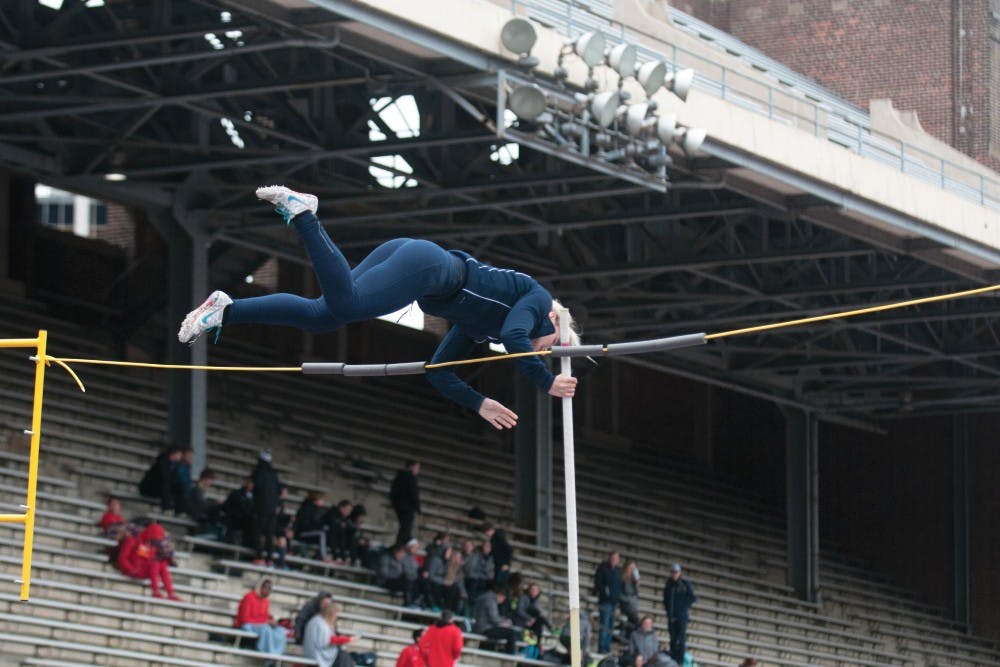
It can be scary to fly around at heights north of 13 feet above the ground, but junior pole vaulter Nicole Macco is one of many Quakers who sets that fear aside day in and day out.
Credit: Yosef RobeleUnderappreciated shouldn’t mean underestimated.
With the track and field season in full swing for the Quakers, the usual events: sprints, relays, and jumps will garner the same high level of media coverage and popularity as they have in past years. Now, it's time for a more holistic understanding of all the high-level athletic events at track meets. So I went out to cover the events and athletes deserving of more respect.
I first sat down with junior Rachel Wilson. She competes in various throwing events for the Quakers, but her specialty is the hammer throw. Contrary to its name, hammer throw has absolutely nothing to do with a traditional hammer. A metal ball, 16 pounds for men and 8.82 pounds for women, is attached to a metal cable and grip. The athlete uses techniques consisting of spins and turns in order to have the hammer land as far away as possible.
What makes the hammer throw interesting is the combination of different ways an athlete can toss the device. Essentially, as long as a player does not go outside the seven foot circle, he or she can use some imagination to find the combination that launches the hammer the farthest.
There's one myth surrounding the throwing events that Wilson wanted to set straight.
“One of the misconceptions is that you have to be really strong and really big in order to throw these events, but that’s not what makes them go far," she said. "With hammer it’s a lot more finesse, and you have to be very smooth and technical with the throw in order for it to go far.”
Like anything else, the hammer throw is straight physics. The athlete is fighting against gravity, release trajectories, and acceleration. When the athlete understands how to manipulate these natural phenomena to his or her advantage, these laws can be friends instead of foes.
I then got a chance to talk to a guy who can be characterized as a jack of all trades. Sophomore Evan Lee competes in the decathlon, which is a series of 10 events over two days.
On the first day, the athlete competes in the 100-meter dash, broad jump, shot put, high jump, and 400m. The second day events are the 110m hurdles, discus throw, pole vault, javelin throw, and 1,500m. It’s truly impressive the amount of different skills a decathlon athlete has to have in order to be successful. Other track athletes can specialize in and refine one event, but these athletes combine ten individual skills at once.
Track and field is officially designated a team sport, but it’s similar to golf, in that you really have to rely on yourself and play your own game. Most fans think the athlete steps on the playing field, does his or her job, and that’s that. However, Lee sees the decathlon differently.
“You’re rooting for your teammates and you're building a lot of camaraderie, and it’s really fun to cheer for the people you’re competing against.”
It’s obvious there are different well-known running and jumping events in the decathlon, but an especially interesting event is the javelin.
Lee put the thrills of the throwing event most bluntly:
“It makes me feel like I’m out hunting caribou.”
A spear that can vary from seven to eight feet depending on regulations, is thrown through the air with the goal of launching it as far as possible. Javelin, like hammer throw, is down to a science, but what makes this event incredibly special is the fact that, unlike in hammer, the technique of the throw is regulated. The javelin has to be thrown over the upper part of the throwing arm, and the athlete is allowed only 98 feet of running path before release.
Release point, velocity, and wind resistance play huge factors and affect outcomes when competing in the javelin event.
Lastly, I spoke with junior Nicole Macco, who competes in the fearless sport of pole vaulting. Pole vaulting stands out among the rest. Compared to distance events, throwing events, and even jumping events, pole vaulting adds a unique dynamic to track and field.
Pole vaulting uses an extremely long pole, which can be crafted from fiberglass or carbon fiber.
Each athlete runs 40 meters and sticks the pole into a depression in the ground. Next, the athlete uses strength and speed to fling himself or herself into the air, trying to vertically clear a bar. The athlete has three tries to clear a height that can reach as high as 20 feet with world records.
What does Macco wish people knew about pole vaulting?
“A lot of people don’t recognize how technical of a sport it is … and it’s very unique in itself.”
Technical it is — technically really difficult. In fact, USA Today ranked pole vaulting as the third hardest event in sports. What makes the event special is that the playing atmosphere can change in every event.
In basketball, the hoop is always 10 feet above the ground, in baseball the bases will be in the same position game after game, and even in track running events, athletes wake up knowing exactly how far they will run. But according to Macco, the starting height for the pole vault is usually unknown entering each meet, and as competition progresses, the height will increase until a winner is determined.
The only thing pole vaulters can be sure of is that they have to give it their all on every jump and risk everything in hopes of clearing the endless number of possible bar heights.
These athletes highlight a few of Penn’s greatest. The psychological and physical demand necessary for track and field athletics is nearly unmatched across every sport — and you should watch these Quakers continue to compete at an extremely high level.

DANIEL WITTMER is a College freshman from Madisonville, Ky., and is a Sports Reporter for The Daily Pennsylvanian. He can be reached at dpsports@thedp.com.
The Daily Pennsylvanian is an independent, student-run newspaper. Please consider making a donation to support the coverage that shapes the University. Your generosity ensures a future of strong journalism at Penn.
Donate



